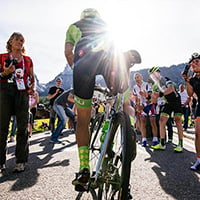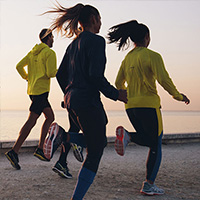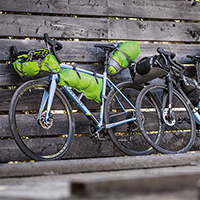RIDING IN WINTER
More and more people are choosing to commute all year round - even during the winter. It’s a great opportunity to get out into the cold, crisp air and keep your fitness levels up. It’s also good for the environment, whilst giving you the perfect excuse to avoid overcrowded subways and buses. Biking in winter is not as hardcore as most people think, you just have to have the right equipment! In this guide we’ll give you some handy tips on what to wear and how to prepare your bike for winter roads.
Winter riding demands a little more planning than riding during the summer months. The weather is cold, wet and snowy so you want to be able to keep warm and dry. Instead of putting on one extra warm jacket, it is better to wear several layers. That way you can easily adapt to changing weather conditions during the ride. Using layers means you can use the same riding kit all year round too.
1. Moisture wicking functional underwear designed to move perspiration away from your skin.
2. A moisture wicking base layer which also moves perspiration away from your skin.
3. A warm mid-layer which absorbs perspiration but holds in the body heat.
4. A protective wind and water-proof jacket or softshell jacket that protects from the wind and rain.
Warm underwear and base layers that have breathable, moisture wicking and fast drying properties are a must have when riding in cold conditions. Depending on the temperature outside you can have on one, two or three layers – you quickly learn how many you need to maintain a good body temperature, and you can use them all year round. We have base layers in both synthetic and wool material which come in different thicknesses.
Synthetic
+/- Cooler
+ Dries quicker
+ Durable
+ Affordable
+ Easy to wash
- More odorous
- Not as warm
- Needs washing more often
Wool
+/- Warmer
+ Keeps its insulating properties when wet
+ Less odour
+ Soft and comfortable
+ Requires less frequent washing
- Needs extra attention when washing
- Not as moisture wicking
- More expensive
Bike jackets and trousers tend to be windproof at the front and have more breathable material on the back, to keep you warm and dry throughout the ride. Many types of jackets are available – a wind jacket is very practical for year-round use as it both protects from wind and is very breathable at the same time. If you want something a little thicker you can opt for a Softshell jacket which gives more protection from wind and rain. It is a little bit warmer but still highly breathable and perfect for chilly autumn and winter rides. In heavy rain conditions, a rain jacket which is 100% waterproof is necessary. It will keep you dry even in the wettest conditions but is less breathable than other jackets and can become sweaty and damp on the inside over time.
A windproof hat and gloves makes the ride a lot more pleasant. There are hats and gloves that only protect against the wind and there are others who also have insulting properties to keep your head and fingers extra warm, which is crucial if you get cold easily or if it’s really cold outside.
Simple yet incredibly useful, shoe covers protect against the wind, rain and mud. There are windproof versions, fully waterproof ones, and of course insulated ones for when the temperature drops. They can be used with road shoes, mountain bike shoes and normal every day shoes. It keeps your shoes and feet dry and clean whether you’re on the trails or on your commute to work.
Just as you have to make some adjustments to your clothing for winter riding, you also have to make some adjustments to your bike so that it will take you from A to B as safely as possible.
It’s not only cars that have summer and winter tyres – bikes do as well. As biking during winter often involves snow and ice, there are a few tyre options to choose from. Studded tyres are available, as are tyres with special winter grips and normal tyres but with more of a pattern.
Studded tyres are great for snowy and icy surfaces. If your road to work or trek through the forest is icy or filled with snow, changing to studded tyres will make all the difference for your riding and safety. Studded tyres work best on hard pack snow, as fresh snow without tracks can be very difficult to ride in even with studded tyres. The wider the tyres, the more grip and stability they offer.
Tyres with a winter grip design are great for surfaces that have been cleared of snow and ice, but still are slippy from rain, road salt and general debris. Winter types are tougher, grippier, roll a little harder on the ground and are much stronger. They also have extra puncture resistance to protect from the extra road debris that come with winter weather. A tyre with a deep thread will provide extra grip on winter roads.
If your winters are not very cold or snowy you can keep running your summer tyres, but make sure you check that they are not too worn down and that they still have grip left. If you are riding a road bike or commuter bike with 28 inch wheels, a pair of cyclocross tyres are a great option for extra grip and stability on wet roads. If you are riding a mountain bike it could be good to change from semi-slick tyres to tyres with more of a pattern for some extra grip on and off road.
Whilst trekking and city bikes tend to come with mudguards, it is not standard for most other bikes such as cross bikes, cyclocross bike, MTBs etc. If you want to ride all year round in both rain and snow it is good to mount a pair on your bike to avoid spray from the road. Depending on what bike you have, and your preference, you can mount clip-on mudguards, bolted-on mudguards or removable mudguards.
When the days get shorter and darker you need to ensure that you’re visible in traffic. It is vital to have a good front and back light as well as some reflective elements on your bike and clothing. According to British law you need to have lights and reflectors on your bike – a white light and white reflex at the front, a red light and reflex at the back and a white or orange reflex on the side of the bike. In our range you’ll find lights with different strengths for mounting on both handlebars and helmets. The strength of the light varies between brands. If you’re on a proper off-road adventure in the forest you need strong lights to get as much out of the ride as possible.
If you leave your bike outside during the day (or night), it is good to remove your clip-on lights so that they are not left out in the cold. This reduces battery life and can damage the wiring.
If you chose to install a permanent light system instead of clip-ons, we would recommend using a dynamo hub instead of the older dynamo version that runs against the sidewall of the tyre.
Rainy, muddy and snowy roads full of wet leaves and road salt result in a muddy bike. It’s not just the aesthetic effects of mud that you need to worry about though - water, mud and salt seep into bearings and parts like the chain which can lead to rust.
If you have the possibility, keep your bike indoors as the cold and rain affect your braking power and gear shifting. The cold also increases the wear and tear on other parts and the frame.
It is important to wash your bike and grease its chain regularly. Check your tyres to make sure there isn’t glass or flints lodged in the grooves that might cause punctures. Also check your brake pads to make sure they are not worn down. Disc brakes are generally better for winter riding as they work better than rim brakes in in harsher environments.
After a long winter of riding it is recommended to give the bike a full service either in a bike shop or at home.







































